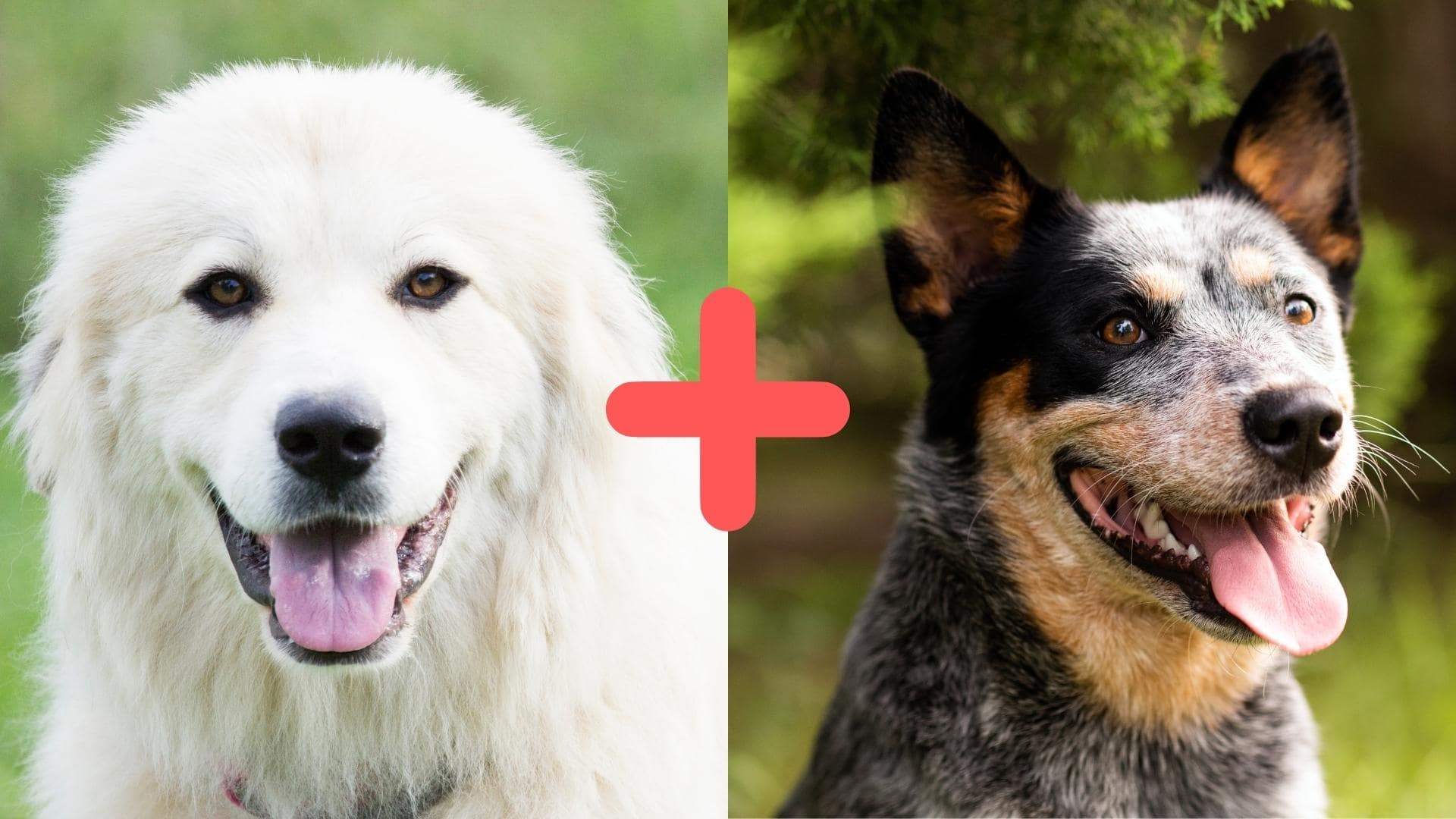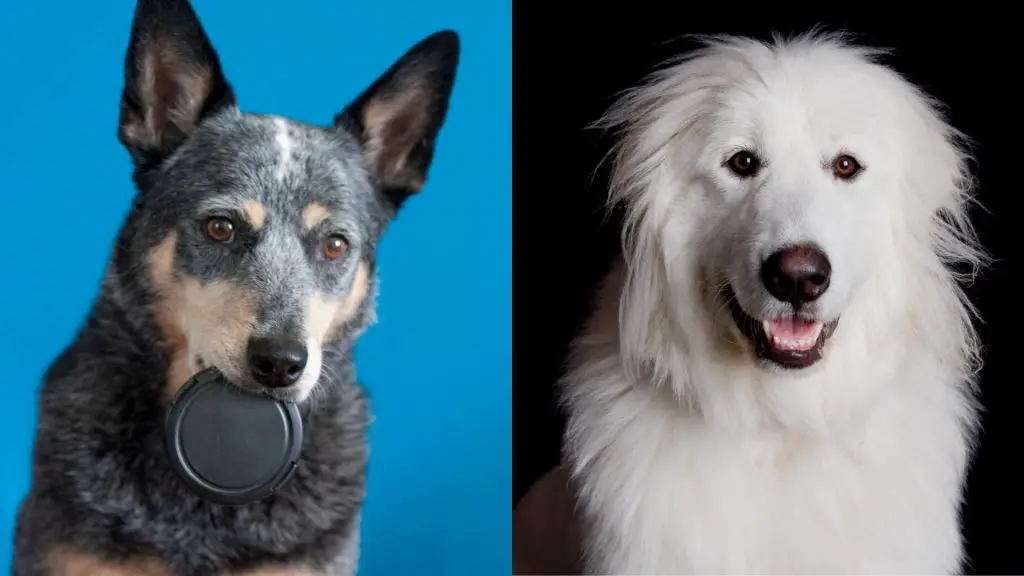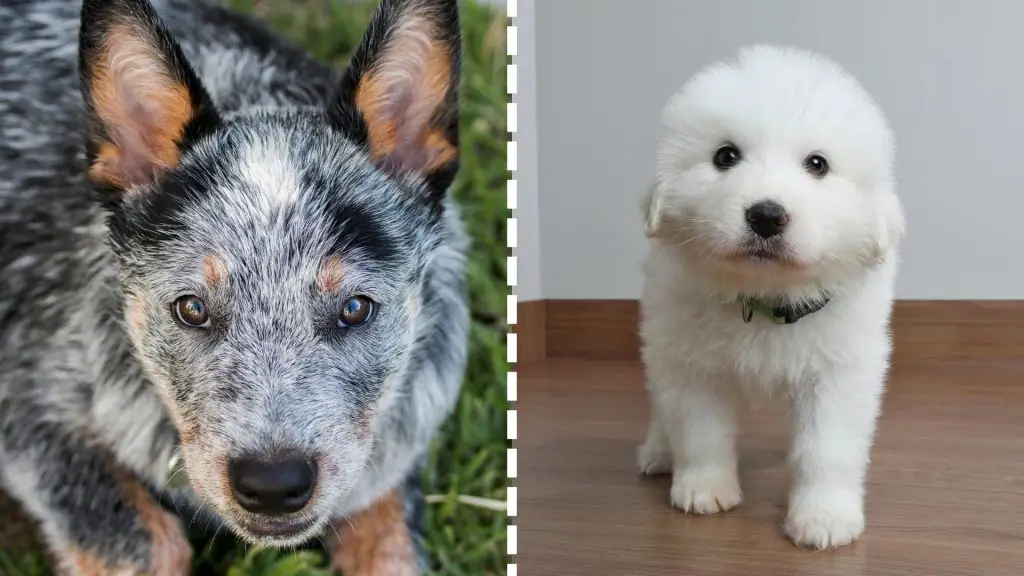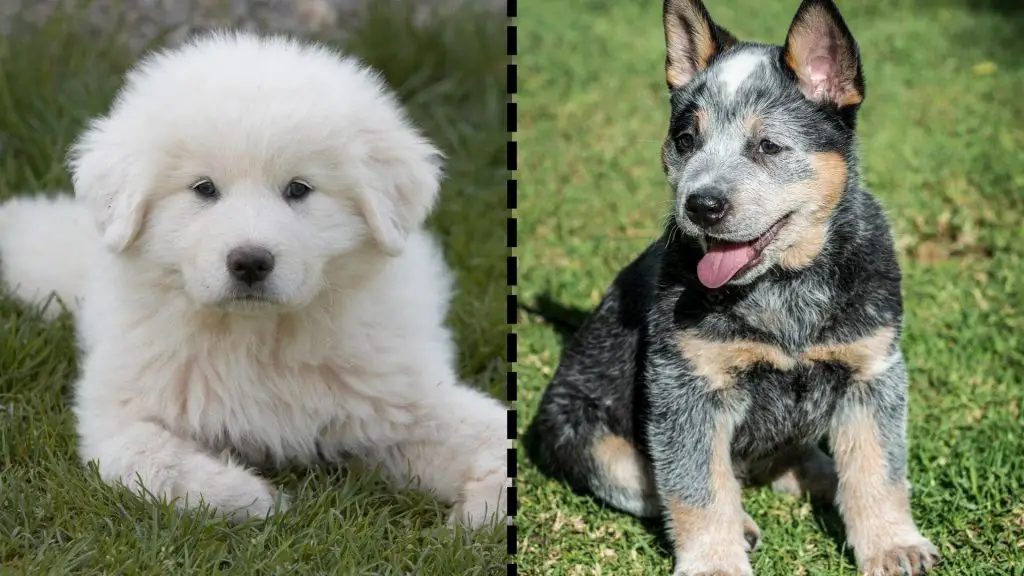Pawscessories is reader-supported. When you buy via links on our site, we may earn an affiliate commission at no cost to you.
Learn more.
Have you ever heard of the Great Pyrenees Blue Heeler mix? It’s a new dog breed that is gaining in popularity. People are drawn to this mix because of its unique looks and great temperament.
In this post, I will cover everything you need to know about the Great Pyrenees Blue Heeler mix. I will talk about its history, what it was bred for, its physical appearance and size, coat colors, temperament, and many other frequently asked questions about this mixed breed.
So let’s jump right in!
Table of Contents

What Is A Pyrenees Heeler?
The Great Pyrenees Blue Heeler mix is a cross between the Great Pyrenees and the Australian Cattle Dog (Blue Heeler). This designer breed was created to have the herding instincts and intelligence of the Blue Heeler with the size, strength, and protective instincts of the Great Pyrenees.
This mix is still relatively new, so there isn’t a lot of information available on them yet. However, we do know that they are intelligent, loyal, and protective dogs. They make great family pets and are excellent with children. They are also good watchdogs with a strong instinct to protect their family and home.
What Was The Great Pyrenees Blue Heeler Mix Bred For?
While both their parent breeds were bred for specific working purposes, the Great Pyrenees Blue Heeler mix was produced primarily for the purposes of companionship. They can be used for various services like guarding, herding, being a watchdog, etc., but it’s not the reason they were created.
For the most part, people loved the features of both Great Pyrenees’ and Blue Heelers and wanted to combine the two into a hybrid dog with the best of both worlds.
Where Do Great Pyrenees’ Come From?
The Great Pyrenees is a large breed of dog from the Pyrenean mountains in southwestern Europe. The breed is most commonly used as a working dog but is also popular as a companion animal.
Great Pyrenees are known for their calm and gentle dispositions, as well as their loyalty and intelligence. The breed has a long history, dating back to the ancient Roman Empire. They were often used as guard dogs, protecting livestock from predators such as wolves and bears.
Over time, the breed spread to other parts of Europe, where it became popular among farmers and shepherds. In the United States, the Great Pyrenees was first introduced in the late 1800s.
Today, the breed is recognized by the American Kennel Club and is considered a versatile working dog. Thanks to their gentle dispositions and trainability, Great Pyrenees make excellent companions for families with children.
Where Do Blue Heelers Come From?
Blue heelers are a type of dog that is also known as an Australian cattle dog. The name “heeler” comes from the dog’s herding instinct to nip at the heels of cows and other livestock. Blue heelers are strong and compact dogs originally bred for herding purposes.
However, they are now also popular as family pets and working dogs in a variety of different fields.
Blue heelers were first bred in Australia in the 1800s from a cross between the dingo and the Staffordshire bull terrier. The original purpose of this breed was to create a dog that could withstand the harsh conditions of the Australian Outback and help with herding cattle. To this end, blue heelers are known for their high level of endurance and tenacious work ethic.
Over the years, blue heelers have been exported all over the world, where they have become popular working dogs in many different professions. They are often used as police, search and rescue, therapy, and service dogs.
Today, blue heelers remain popular family pets and working dogs. They are intelligent, loyal, and hardworking animals that make great companions.
Great Pyrenees Blue Heeler Mix Appearance & Traits

Size (Weight & Height)
The Great Pyrenees Blue Heeler mix is a large dog, with males reaching heights of up to 32 inches and females 27-28 inches. They weigh anywhere from 65 to 140 pounds.
If they take after their Great Pyrenees parent more, they’ll be a larger adult dog, and vice versa if they take after their Blue Heeler parent more.
Coat Colors & Texture
The coat colors of a Great Pyrenees Blue Heeler mix can be pretty varied. They can inherit the pure white coat of the Great Pyrenees, or they can have dark accents on their face and legs with black spots over their body like Blue Heelers.
Their coat is thick and double-layered, providing protection against the elements. The outer coat is long and coarse, while their inner coat is soft and dense.
Shedding & Grooming
Great Pyrenees Blue Heeler mixes are heavy shedders. They will shed more during the spring and fall months as they “blow out” their coat. They will still shed during the rest of the year, but not as much. Daily brushing is recommended to help control the shedding.
Many parents of this breed opt to get a robot vacuum to help them stay on top of all their shedding. Of course, they don’t keep your home completely free of their fur, but they help keep the mess manageable throughout the week.
Also, it’s a good idea to use a dog blow dryer to blow out their coat during the high shedding seasons. Simply taking them outside in your backyard and blow drying their coat can help get rid of a lot of their loose fur before it finds its way all over your home.
Great Pyrenees Blue Heeler mixes can also be heavy droolers. They tend to slobber and drool more when they are excited or nervous. This is due to their loose lips and jowls. Drool bibs may be necessary to keep your dog (and your furniture) clean.
Great Pyrenees Blue Heeler mixes are not high maintenance when it comes to the other aspects of grooming. A bath every few months should suffice unless they get into something smelly or dirty. Their nails will also need to be trimmed regularly, and their ears cleaned.
Lastly, they should have their teeth cleaned a couple of times a week, whether that’s through brushing or with dental chew sticks.
Are Great Pyrenees Blue Heeler Mixes Hypoallergenic?
No, Great Pyrenees Blue Heeler mixes are not hypoallergenic. They are heavy shedders and produce dander that many people with dog allergies are allergic to.
Ears & Tail
The ears of a Great Pyrenees Blue Heeler mix are typically triangular in shape and sit high on their head. They have a long tail that is thick at the base and tapers to a point.
Some Pyrenees Heeler mixes may have their tails docked (or removed) when they are born. This is done for two reasons: to prevent injury and to make them look more like their Blue Heeler parent.
Eye Color
The eyes of a Great Pyrenees Blue Heeler mix can be any color, such as hazel, black, or even blue (though not as likely), but are most often brown.
Lifespan

The average lifespan of a Great Pyrenees Blue Heeler mix is between 11 and 13 years.
Their lifestyle, diet, and overall health will all play a factor in how long they live. Great Pyrenees Blue Heelers that are well-cared for and live a healthy lifestyle can sometimes exceed their breed’s average lifespan.
Common Health Issues
Great Pyrenees Blue Heeler mixes are generally a healthy breed. However, like all dogs, they can be prone to certain health issues. Some of the more common health issues seen in this breed are elbow and hip dysplasia, eye problems, and bloat.
Elbow and hip dysplasia are both hereditary conditions that can cause joint pain and lameness.
Eye problems such as cataracts, glaucoma, and cherry eye are also seen in this breed.
Bloat is a condition that can occur when a dog’s stomach fills with gas and twists. It is a severe condition that can be fatal if not treated immediately.
Great Pyrenees Blue Heeler mixes are also prone to weight gain. This is why it’s important to ensure they get plenty of exercise and eat a healthy diet.
If you are considering getting a Great Pyrenees Blue Heeler mix, be sure to do your research and talk to your veterinarian about any health concerns you may have.
Trainability & Intelligence

Great Pyrenees Blue Heeler mixes are very intelligent dogs. They are quick learners and, because of their parent’s working backgrounds, love to please their owners.
This breed is easier to train than many other breeds and is a great choice for first-time dog owners. They respond well to positive reinforcement training methods, such as treats, praise, and play.
When it comes to training them to be well-behaved around other dogs and strangers, socialization is crucial. This means giving them positive exposure to different people and situations at an early age so they can learn how to behave correctly.
The more positive experiences they have with unfamiliar dogs and people, the better they’ll behave in new situations as they get older.
Activity Level & Exercise Needs
Great Pyrenees Blue Heeler mixes are high-energy dogs that need plenty of exercise. The Blue Heeler in them was bred to work all day and therefore have a lot of energy to burn.
This breed needs at least 45 minutes to an hour of exercise every day. A good mix of physical activity and mental stimulation will help keep them happy and healthy.
Some of the best activities for this breed include hiking, running, playing fetch, and going to the dog park.
If they don’t get enough exercise, they can become bored and destructive. This is why it’s important to make sure they get plenty of physical and mental stimulation every day.
Some Great Pyrenees Blue Heeler mixes can also be escape artists. They are very intelligent and have a strong desire to explore. This means having a secure, well-made fence at least six feet tall is a good idea.
Temperament & Behavior

Do Great Pyrenees Blue Heeler Mixes Bark A Lot?
This is a common question about this breed since the Great Pyrenees is known for being very quiet. But on the other hand, the Blue Heeler is known for being very vocal.
So, which parent’s temperament does this breed inherit? The answer is a little bit of both.
Great Pyrenees Blue Heeler mixes can be quite vocal, especially when they’re excited or trying to get your attention. However, they are not typically considered to be yappy dogs.
This breed is also known for being very loyal and protective of their family. They are natural guardians and will bark to warn you of any strangers or potential threats.
Do Great Pyrenees Blue Heeler Mixes Like To Cuddle?
This is another common question about this breed. The Great Pyrenees is known for being a very affectionate and cuddly dog, while the Blue Heeler is not typically known for being overly affectionate.
So, which parent’s temperament does this breed inherit when it comes to cuddling? The answer is that it depends on the individual dog.
Some Great Pyrenees Blue Heeler mixes are very affectionate and love to cuddle, while others may not be as keen on it. It really depends on the individual dog’s personality and their experiences with cuddling as a young puppy.
Are Great Pyrenees Blue Heeler Mixes Good With Kids?
Great Pyrenees Blue Heeler mixes can be great with kids. They are loyal, protective, and affectionate dogs that love being around their family.
However, it’s important to give them plenty of opportunities to socialize with kids to learn how to behave properly around them.
Because Blue Heelers have herding backgrounds, you may find they nip at the heels of people in your home to keep everyone together. But with proper training and guidance, this can be avoided.
Are Great Pyrenees Blue Heeler Mixes Good With Other Dogs?
The Great Pyrenees Blue Heeler mix is generally good with other dogs. However, socialization is important in order for them to learn how to appropriately interact with other dogs.
While they’re not known for being aggressive with other dogs… It’s still important for them to have plenty of positive interactions with new dogs to help them be well-rounded, well-behaved adults.
Are Great Pyrenees Blue Heeler Mixes Good With Strangers?
The Great Pyrenees Blue Heeler mix can be wary of strangers. They are bred to be natural guardians and are likely to bark to warn you of any potential threats.
However, with proper socialization, they can learn to be friendly and welcoming to new people.
Are Great Pyrenees Blue Heeler Mixes Good Apartment Dogs?
Great Pyrenees Blue Heeler mixes can be good in apartments, but it’s not an ideal living situation for them.
Not only are they quite large, but they require a good amount of daily exercise in order to stay happy and healthy.
If you live in an apartment, it’s important to ensure you can provide them with plenty of opportunities to get out and run around. This may include taking them on long walks or runs, to the dog park, or even doggy daycare.
What Is The Price Of A Great Pyrenees Blue Heeler Mix?

The price of a Great Pyrenees Blue Heeler mix can vary depending on the breeder and the specific circumstances.
However, you can expect to pay anywhere from $500 to $2000 for a Pyrenees Heeler puppy.
The price may be higher if the dog comes from a show-quality bloodline or has champion parents.
Be very careful when you see a Great Pyrenees Blue Heeler going for low prices.
Always make sure you are getting them from a reputable breeder.
There are many unscrupulous breeders out there who are looking to make a quick buck by selling sick or unhealthy puppies.
Where Can You Buy A Great Pyrenees Blue Heeler Mix?

There are a few different places you can buy a Great Pyrenees Blue Heeler mix.
The most obvious place to start is by finding a reputable breeder.
There are plenty of online breeder directories available to help you find a breeder with the dog you’re looking for. A couple of more well-known breeder directories are Greenfield Puppies and Lancaster Puppies.
Suppose you don’t have any luck finding a breeder in your area. In that case, the next best option is to check your local shelters or rescue organizations.
Many times, these organizations will have mixed-breed dogs available for adoption.
Another option is to check online classifieds websites such as Craigslist or Facebook Marketplace.
Just be very careful when choosing this option, as there are many scams associated with these websites.
Always make sure you meet the seller in person and see the puppy before giving them any money.
Similar Breeds To The Great Pyrenees Blue Heeler Mix
- Blue Heeler Corgi mix (AKA the Cowboy Corgi)
- Blue Heeler Jack Russell mix (AKA Cattlejack)
- The Catahoula Australian Cattle Dog mix (AKA Catahoula Blue Heeler)
Final Thoughts
The Great Pyrenees Blue Heeler mix is a large, loyal, and friendly dog that makes a great addition to any family.
They are intelligent, easy to train, and make great watchdogs. While they require plenty of exercise, they are relatively low-maintenance dogs that are relatively easy to care for.
If you’re looking for a big, cuddly, and lovable dog, the Great Pyrenees Blue Heeler mix may be a great addition to your family.
Other posts you might find interesting:
